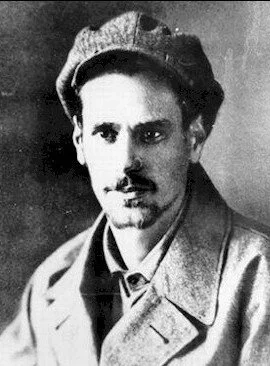Yuriy Kondratyuk: A Ukrainian Mathematician Ahead of His Time
Born as Oleksandr Hnatovych Shargei in 1897, Yuriy Kondratyuk was a Ukrainian engineer and mathematician. Yuriy is most known for developing the first known lunar orbit rendezvous, henceforth abbreviated as “LOR”.
His father also had a strong interest in math and physics and studied at Kyiv University at the time of his birth. At an early age, Yuriy took an interest in his father’s books concerning the aforementioned subjects and began studying related concepts himself at the Great Polytechnic in Petrograd in the faculty of engineering. Yuriy was drafted during the first world war, though during this time he developed and recorded his early ideas concerning space flight. He left the military after the Russian Revolution in 1918 and attempted to flee to Poland, as former officers of the pre-Soviet Russian imperial army were high on the “enemy of the people” list at risk for arrest and imprisonment (or worse).
Though he was turned back at the Polish border, he eventually was able to obtain forged paperwork under the name most people know him as today, “Yuriy Kondratyuk”.
Eventually, he was imprisoned in 1930 as a “saboteur” by the NKVD for inventing a grain elevator without nails. The problem was less about him inventing a grain elevator and more about the Soviet government inventing an excuse to arrest inventors and other scientists and engineers.
The Soviet Union was very much in favor, on one hand, of science and technology. But, the free exchange of ideas was not welcome under the Soviet Union. Inventors such as Kondratyuk were deemed to be part of the “bourgeois intellectual" class that communism opposed. Under communism, the two classes that were recognized to exist were the labor masses and the political class; inventors and intelligentsia fell somewhere in between and threatened to undermine the political structure’s legitimacy. It is important to not that in any totalitarian society, objective viewpoints are not allowed, as they may serve to poison the class consciousness of revolutionary socialism. Under this system, scientists either fled or were imprisoned in their own version of a slave labor camp. Such was the solution of the Soviet Union as a reconciliation of how to integrate technological advance under communism.Some are surprised at this, given the murderous behavior of the Soviet government towards their own people, though it could perhaps best be understood through the words of Lenin himself: “One must spare a great scientist or major specialist in whatever sphere, even if he is a reactionary to whatever degree”. So, while most others would be murdered without a second thought under this regime, they would at least be so charitable so as to enslave you if you happened to be a scientist, so as to address the sudden not-so-inexplicable drain of such people under communism.
What is LOR?
What is this LOR of Kondratyuk, and what is its significance? Basically, Yuriy’s LOR he proposed in 1919 is the most economic method to send an astronaut to the moon and back. Those that are familiar with the Apollo missions are aware that there were two modules used to perform the lunar landing in those missions. One capsule is termed the “lunar module”, which allowed astronauts to land on the moon after it reached lunar orbit. The second module, termed the “command and service module”, carried the astronauts and the lunar module to the moon, remained in orbit while the lunar module and its occupants performed their tasks on the lunar surface, then finally brought the astronauts back to Earth upon mission completion. Yuriy Kondratyuk’s idea mirrored this “mother ship / daughter ship” concept that was ultimately used during the Apollo era.
Other accomplishments include proposing a satellite be “slingshot”, that is to say, using planetary gravity, to boost itself to a sufficient speed such that it saved power and time to increase a satellite’s speed in the case of interplanetary travel.
2002 commemorative Ukrainian postage stamp of Kondratyuk
Kondratyuk worked on wind turbines as a power resource until he eventually joined the Red Army during the Great Patriotic War until his disappearance in 1942.
Kondratyuk featured on a Ukrainian 2 Hryvnia coin
Originally established in 1930, in June of 1997, Poltava Construction Engineering Institute of Ukraine was renamed after the late astronautic theoretician as Yuriy Kondratyuk University. Since achieving national status in 2002, the name of the university now stands as “Poltava National Technical Yuriy Kondratyuk University”. More information about this university can seen following the link in the “acknowledgements”.
In 2012, www.google.com celebrated Yuri’s 115th birthday with this splash page cover.
Neil Armstrong himself, during his visit to the former USSR. Took a handful of dirt from outside of Kondratyuk’s former home in Novosibirsk to acknowledge his contribution to manned spaceflight. Since then, the townships have further acknowledged Kondratyuk with the renaming of some streets in Poltava, Kyiv, Moscow and Novosibirsk after him. A minor planet has been named after him as well as a crater on the moon.
One of Yuri’s works that can be read, should the reader be interested, includes his “Conquest of Interplanetary Space” written in 1925. It shows “currently out of print” on www.amazon.com but may be found in limited quantity from time to time from various sources of used and out-of-print books.
Yuri was inducted into the International Space Hall of Fame in 2014, a program of the New Mexico Museum of Space History in Alamogordo, New Mexico, United States, linked in the “acknowledgements”.
The book “Yuriy Kondratyuk (Alexander Shargey): the Son of Ukraine, the Son of Poltava” by Anatoliy Datsenko was published in 1997 and republished in 2000 . “Yuriy Kondratyuk (Alexander Shargey) in the Memories of His Contemporaries” was a book published in Ukrainian in 2007 and English in 2017. In the journal “Philosophy and Cosmology. Volume 21, 2018”, the effort to translate technical terms used in these books from Russian to Ukrainian equivalents is discussed and may be of interest to those interested in the preservation of Ukrainian language and culture. A link will be provided in the “acknowledgements”.
Acknowledgements
Aliaiev, G., Cherednik, L., & Chernyshov, V. (2018). Yuriy Kondratyuk’s Name Was Written in Her Heart. Philosophy and Cosmology, 21, 159–164. doi: 10.29202/phil-cosm/21
Dunbar, B. (2008, April 22). Lunar Orbit Rendezvous and the Apollo Program. Retrieved September 30, 2019, from https://www.nasa.gov/centers/langley/news/factsheets/Rendezvous.html.
New Mexico Museum of Space History. (n.d.). New Mexico Museum of Space History " Alamogordo, New Mexico " Celebrating the significant role the state of New Mexico has played in the development of the U.S. Space Program. Retrieved September 30, 2019, from http://www.nmspacemuseum.org/.
Star Education. (2019). Poltava National Technical University named after Yuri Kondratyuk. Retrieved September 30, 2019, from https://www.edu-ukraine.com/universities-of-ukraine/engineering-universities/42-poltava-national-technical-university-named-after-yuri-kondratyuk.html.ПолтНТУ. (n.d.).
PoltNTU: Poltava National Technical Yuri Kondratyuk University. Retrieved September 30, 2019, from https://pntu.edu.ua/en.
ABOUT THE AUTHOR
Nicholas Chudolij is graduate student within American Public University's Space Studies faculty, Astronomy track. Nicholas loves traveling, fishing, competitive marksmanship and playing the flute.








